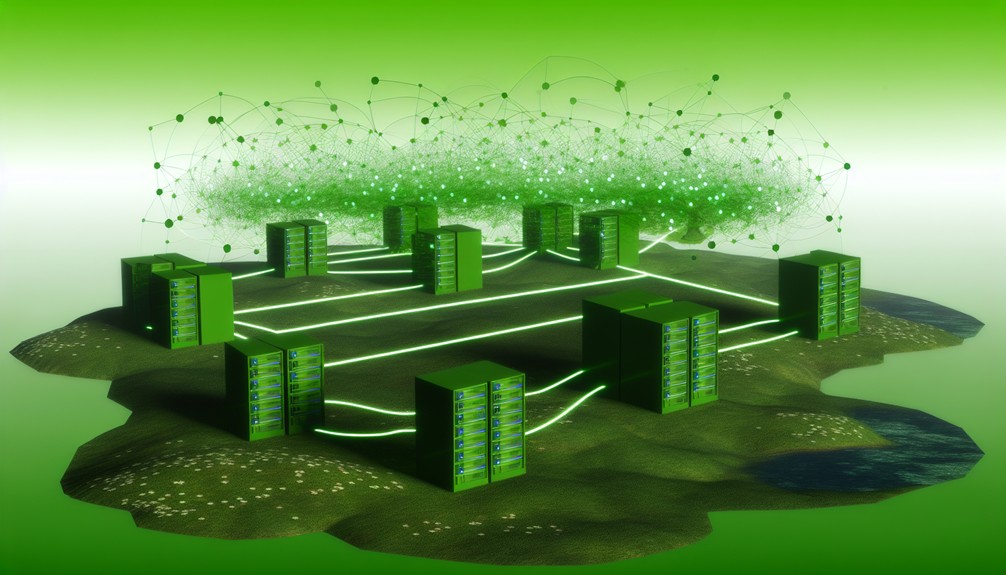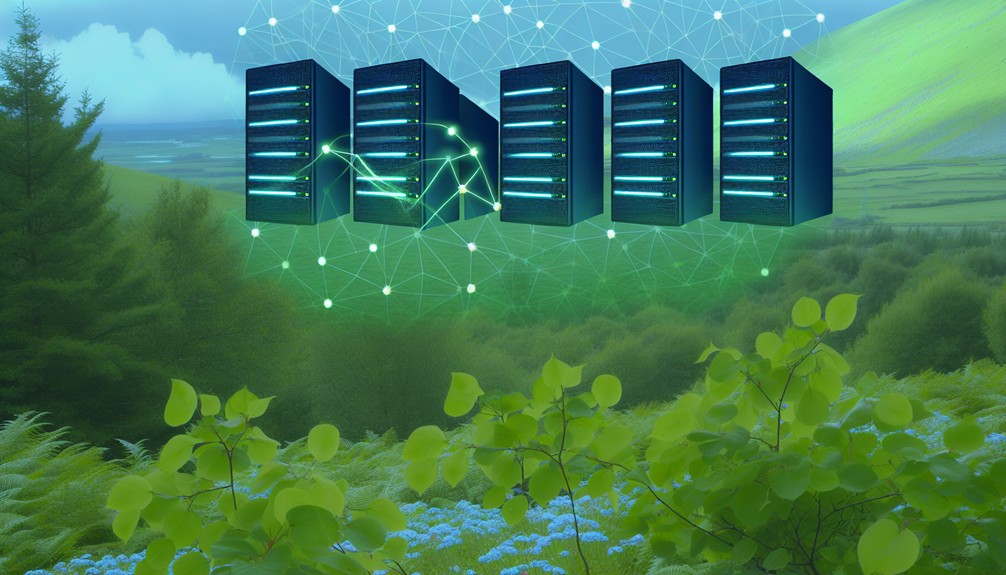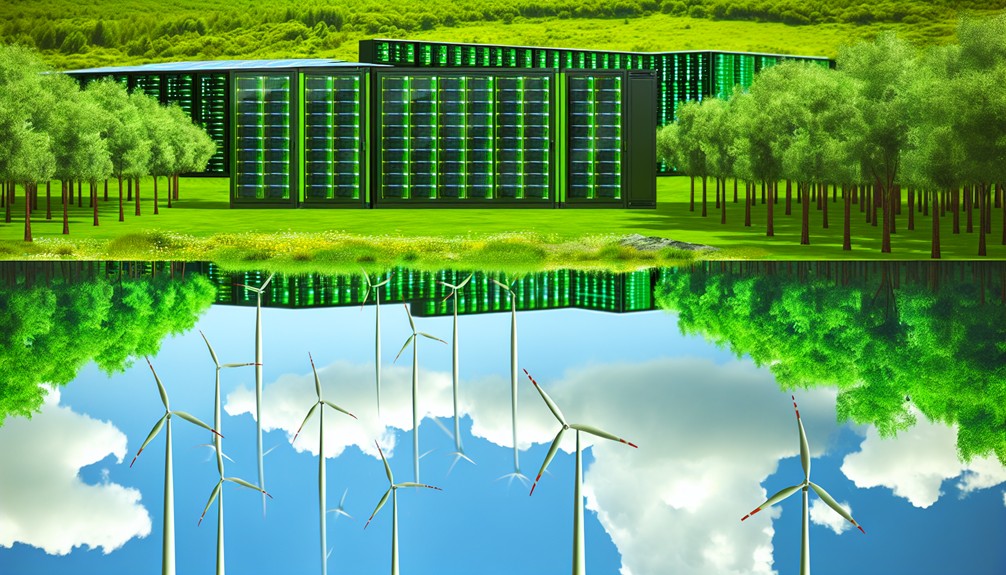It’s no coincidence that while you’re searching for ways to be more environmentally conscious, Smart DNS technology emerges as a solution to reduce streaming’s carbon footprint. As you stream your favorite shows, you might not realize the significant environmental impact involved. But what if there’s a way to enjoy diverse content sustainably? By optimizing data routes, Smart DNS lowers energy consumption and reduces emissions without sacrificing speed. You’re about to discover how this technology not only maintains performance but also prioritizes the planet, opening a new chapter in eco-friendly viewing. Smart DNS isn’t just about access – it’s the first step toward true eco-friendly viewing in the digital age.
Key Takeaways
- Smart DNS reduces energy consumption by rerouting DNS queries without encryption, minimizing data center loads.
- It optimizes data paths, enhancing streaming efficiency and reducing unnecessary energy usage.
- Smart DNS improves server efficiency through reduced bandwidth and enhanced load times.
- Unlike VPNs, Smart DNS focuses on geo-unblocking without heavy encryption, leading to faster streaming and lower carbon emissions.
- It enables geographically diverse content access while promoting sustainable practices through efficient data management.
Understanding Streaming’s Environmental Impact

Streaming media has become an integral part of modern entertainment, yet its environmental impact is often overlooked. As you engage in streaming consumption, consider the digital waste generated by the vast data centers powering your favorite content. These facilities require immense energy to operate, contributing significantly to carbon emissions. Eco-friendly viewing begins with understanding the invisible toll streaming takes on global energy resources.
In fact, the global carbon footprint of the internet and its supporting systems is estimated to rival that of the aviation industry.
In your quest for innovation, it’s essential to understand how your streaming habits contribute to this environmental challenge. Each video streamed demands data transmission through extensive networks, intensifying energy usage.
For instance, streaming a single hour of high-definition video can result in approximately 3.2 kg of CO2 emissions, equivalent to driving a car for 12 kilometers.
What Is Smart DNS Technology?

You can optimize your streaming experience with Smart DNS technology, which reroutes only your DNS queries to bypass geo-restrictions without encrypting your entire internet traffic.
This approach consumes less energy compared to VPNs, which encrypt all data, making Smart DNS a more sustainable choice for accessing global content.
Consider the benefits of reduced latency and faster speeds with Smart DNS while weighing its security limitations against VPNs for your specific needs. When compared to traditional methods, Smart DNS emerges as a natural ally in promoting eco-friendly viewing through intelligent data handling.
How Smart DNS Works
Smart DNS technology serves as a crucial tool in optimizing your streaming experience by bypassing geographical content restrictions, without impacting your internet speed. Unlike VPNs, Smart DNS doesn’t encrypt your data. Instead, it reroutes specific traffic related to geo-blocked content through a proxy server. This process leverages smart DNS advantages like maintaining your original IP address and ensuring minimal latency. As a result, Smart DNS applications are ideal for accessing international libraries on platforms like Netflix, Hulu, or BBC iPlayer seamlessly. Eco-friendly viewing is achieved by rerouting only essential data, leaving minimal digital waste and reducing server strain.
Imagine your data as a train. Smart DNS acts as the switch that ensures only necessary tracks are altered, keeping your journey swift and efficient. This ensures that the environmental footprint of streaming is reduced by optimizing data paths and minimizing energy consumption on unnecessary encryption processes.
Here’s a closer look at how Smart DNS functions:
| Feature | Traditional DNS | Smart DNS |
|---|---|---|
| Speed | Standard | Optimized |
| Encryption | None | None |
| Geo-Restriction Bypass | Limited | Extensive |
| IP Address Visibility | Maintained | Maintained |
| Data Rerouting | No | Selected Content Only |
Benefits of Smart DNS
Unlock the potential of Smart DNS technology, and you’ll discover an array of benefits designed to enhance your streaming experience while promoting sustainability.
By optimizing data routing for faster connection speeds, Smart DNS reduces energy consumption, translating into cost savings for you and a smaller carbon footprint. It significantly improves user experience through seamless service compatibility across devices, ensuring you can stream without interruptions. Smart DNS turns sustainable streaming into a reality, making eco-friendly viewing seamless and accessible for everyone.
Smart DNS provides geographical flexibility, allowing access to a wider content variety from different regions without compromising privacy protection. Its setup simplicity means you can start enjoying these benefits with minimal technical hassle, making it accessible to all users.
Performance enhancement is also a notable advantage, as Smart DNS optimizes your connection, reducing buffering and latency issues.
Here’s what you can expect:
- Effortless Streaming: Enjoy enhanced performance and speed for a smooth user experience.
- Global Access: Unlock content variety with geographical flexibility, expanding your viewing horizons.
- Energy Efficiency: Contribute to sustainability through optimized data usage, reducing environmental impact.
- Seamless Setup: Benefit from setup simplicity and service compatibility, making it easy to access features immediately.
Smart DNS vs. VPN
Navigating the world of online streaming and privacy solutions often leads to a comparison between Smart DNS and VPN technologies.
You’ll find that Smart DNS has distinct advantages, particularly when it comes to bypassing restrictions and optimizing connection speeds. Unlike VPNs, which encrypt all your data, Smart DNS focuses on rerouting only the information necessary to unlock geo-restricted content, resulting in faster streaming speeds. This makes a significant difference in user experience, especially if you’re keen on uninterrupted, high-quality streaming.
Smart DNS also shines in specific usage scenarios where speed and simplicity are prioritized. While VPNs offer data encryption, which is crucial for streaming privacy and security, they come with limitations such as reduced speeds and potentially increased environmental impact due to higher data processing requirements.
If you’re primarily focused on accessing content and maintaining connection efficiency, Smart DNS could be more sustainable and cost-effective.
Cost comparison reveals that Smart DNS often requires less investment than a comprehensive VPN service. However, it’s essential to weigh security concerns, as Smart DNS doesn’t provide the same level of privacy protection.
Your choice depends on your priorities: speed and accessibility versus comprehensive security. For those prioritizing eco-friendly viewing, Smart DNS offers a low-impact alternative to energy-intensive VPNs.
How Smart DNS Optimizes Streaming

Imagine you’re streaming your favorite show, and it’s as smooth as a whisper over the internet. With Smart DNS, streaming quality is elevated by optimizing bandwidth management, ensuring a seamless user experience. This technology strategically reroutes your connection through the most efficient paths, minimizing latency and enhancing content accessibility.
- Enhanced Streaming Quality: Smart DNS prioritizes your data flow, optimizing bandwidth and allowing you to enjoy high-definition content without buffering interruptions.
- Efficient Bandwidth Management: By streamlining the data flow, Smart DNS reduces unnecessary congestion, saving resources and improving your overall viewing experience.
- Latency Reduction: With Smart DNS, data caching is utilized to store frequently accessed content closer to your location, significantly reducing load times and ensuring rapid access to your favorite shows.
- Seamless Content Accessibility: Smart DNS empowers you to access global content libraries effortlessly, bypassing geo-restrictions and offering a wider range of viewing options.
This innovative approach not only enhances your viewing experience but also aligns with sustainable practices by reducing the demand on data centers.
Smart DNS is more than just a tool; it’s a gateway to efficient, eco-friendly streaming that’s ready to transform your digital consumption.
Reducing Carbon Emissions With Smart DNS

Leveraging Smart DNS for streaming isn’t just about improving your viewing experience; it also plays a crucial role in reducing carbon emissions. By optimizing data routes, Smart DNS minimizes latency and enhances data flow efficiency. This reduced distance for data travel directly impacts energy consumption by lowering the power required for data transmission. Eco-friendly viewing becomes tangible when you choose streaming methods that directly reduce server energy consumption.
With over 60% of the internet’s carbon footprint attributed to video streaming, Smart DNS offers a scalable solution to mitigate this environmental burden.
When you utilize Smart DNS, you’re effectively reducing the load on data centers. These centers are notorious for high energy consumption, responsible for roughly 1% of global electricity use. By streamlining data paths, Smart DNS decreases the need for energy-intensive processes, thus cutting down carbon emissions.
Imagine a world where your streaming habits contribute to a cleaner planet – Smart DNS makes that a reality.
Moreover, Smart DNS’s ability to bypass geo-restrictions without compromising speed adds an innovative edge. It reduces redundant data cycles, further decreasing your carbon footprint.
In adopting Smart DNS, you’re not only enhancing your access to content but actively participating in a movement towards sustainable streaming.
Energy Efficiency Through Data Optimization

You can significantly reduce energy consumption by optimizing data transfer processes in streaming services.
By focusing on minimizing data transfer, you’re not only cutting down on bandwidth but also enhancing server efficiency, which directly impacts energy use.
Implementing these optimizations contributes to a more sustainable digital ecosystem, where less energy is required to maintain high-quality streaming experiences.
Minimizing Data Transfer
Reducing data transfer is crucial in enhancing energy efficiency, particularly in the context of streaming services. You can achieve this by implementing data compression techniques and bandwidth reduction strategies. These approaches not only optimize your streaming experience but also contribute significantly to sustainability.
By minimizing the amount of data transferred, you reduce the energy consumption required to deliver content, effectively lessening the environmental impact of streaming.
Consider these compelling reasons to minimize data transfer:
- Lower Energy Consumption: Efficient data compression reduces the energy used by servers and network infrastructures, resulting in a smaller carbon footprint.
- Faster Load Times: Optimizing data transfer through bandwidth reduction decreases buffering times, providing a smoother and more enjoyable viewing experience.
- Cost Savings: Reduced data transfer translates to lower operational costs for service providers and potentially lower subscription fees for you.
- Environmental Stewardship: By embracing data efficiency, you take an active role in promoting sustainability and reducing the environmental impacts associated with digital consumption.
In an era where digital innovation intersects with environmental responsibility, adopting techniques that minimize data transfer is a forward-thinking approach that aligns with the global push towards greener technologies.
Enhancing Server Efficiency
Enhancing server efficiency plays a pivotal role in achieving energy savings through data optimization. By streamlining server resource allocation, you can significantly reduce the environmental footprint of streaming services.
Smart DNS technology optimizes data paths, cutting down unnecessary data travel and minimizing server load. This optimization directly impacts energy management by reducing the energy required per data transaction, leading to lower carbon emissions.
You should focus on deploying advanced algorithms that intelligently manage server resource allocation. These algorithms can predict demand patterns and adjust server capacities accordingly, preventing over-provisioning and underutilization.
By doing so, you not only enhance server efficiency but also contribute to a more sustainable digital ecosystem.
Data-driven decisions in server operations mean that you can identify and eliminate bottlenecks in real-time. Implement monitoring tools that offer insights into server performance and energy consumption metrics.
This granular visibility allows for precise energy management, ensuring that each server operates at peak efficiency. By prioritizing sustainability in server operations, you’re not just cutting costs – you’re pioneering a path toward greener technology.
Embrace these innovative practices to lead the charge in reducing streaming’s ecological impact.
Minimizing Server Load and Energy Use

Streaming platforms’ environmental footprint can be significantly reduced by minimizing server load and energy use. By focusing on server efficiency and energy conservation, you can leverage load balancing and resource management to optimize bandwidth. Minimizing server loads is a foundational principle of eco-friendly viewing through smarter data delivery systems.
This approach not only enhances environmental awareness but also maximizes the technology impact of your streaming services.
To achieve these goals, consider the following strategies:
- Implement Load Balancing: Distribute incoming data requests across multiple servers to prevent any single server from becoming overburdened. This ensures efficient use of resources while conserving energy.
- Optimize Bandwidth Usage: Use advanced algorithms to dynamically adjust streaming quality based on user connection speeds, ensuring minimal data wastage and reducing energy consumption.
- Enhance Server Efficiency: Upgrade to energy-efficient server hardware and software systems that deliver more processing power per watt, reducing overall energy demands.
- Adopt Sustainable Practices: Regularly evaluate and update your infrastructure to incorporate the latest in green technology, demonstrating a commitment to reducing your environmental impact.
Smart DNS vs. Traditional Streaming Methods

The choice between Smart DNS and traditional streaming methods significantly influences the environmental impact of your viewing habits. With Smart DNS, you gain advantages like reduced latency and efficient data routing, translating to lower carbon footprints. In contrast, traditional streaming methods often involve higher energy consumption due to inefficient data paths and server loads. By understanding these differences, you can make more eco-conscious decisions. Eco-friendly viewing gains an edge with Smart DNS, whose optimized pathways contrast starkly with the energy-heavy inefficiencies of traditional streaming.
Here’s a quick comparison:
| Feature | Smart DNS Advantages | Traditional Streaming Drawbacks |
|---|---|---|
| Data Routing | Optimized paths reduce energy use | Often inefficient, increasing load |
| Latency | Lower latency for smoother experience | Potentially higher, causing buffering |
| Server Load | Decreased load, conserving resources | Increased load, straining resources |
| Carbon Footprint | Reduced, supporting sustainability | Higher, contributing to emissions |
Smart DNS uses geo-targeting to bypass unnecessary data centers, which means less energy consumption and a smaller carbon footprint. Traditional streaming methods, however, rely heavily on centralized servers, which can become overloaded. This inefficiency leads to more energy usage and ultimately a larger environmental impact. By choosing Smart DNS, you’re not just enhancing your viewing experience; you’re also taking a step towards sustainable innovation.
Real-World Examples of Eco-Friendly Streaming

In the realm of eco-friendly streaming, several companies have stepped up, showcasing how technology can align with sustainability goals. These innovators have embraced sustainable platforms, ensuring their operations leave a minimal environmental footprint.
For example, Netflix has committed to carbon neutral services by 2022, aiming to offset emissions through renewable resources. Meanwhile, BBC Studios focuses on green content creation, integrating eco initiatives into their production processes.
Let’s explore some inspiring examples:
- Netflix’s Renewable Energy Pledge: By powering their streaming through 100% renewable resources, Netflix reduces its carbon output significantly, achieving low impact streaming.
- BBC’s Albert Initiative: This program supports producers in creating sustainable platforms for content, focusing on energy efficient codecs and waste reduction.
- Amazon Prime’s Carbon Footprint Analysis: Amazon has implemented a rigorous carbon analysis, aiming for carbon neutrality and promoting energy efficient codecs to lower energy use.
- YouTube’s Eco Initiatives: By optimizing data centers with renewable energy, YouTube ensures that its services align with carbon neutral goals, focusing on low impact streaming.
These examples underscore the importance of innovation in streaming technology. By embracing these eco-friendly practices, you’re supporting a vision where entertainment and sustainability coexist harmoniously.
Future Innovations in Green Streaming Technology

As technology evolves, the possibilities for green streaming innovations seem endless, promising a future where digital entertainment and environmental stewardship are seamlessly integrated. You can expect sustainable content to flourish through innovative codecs that minimize data usage without sacrificing quality. This shift is crucial for eco conscious consumers who value both entertainment and planet preservation.
Future infrastructures will leverage renewable energy and carbon neutral servers to power streaming services efficiently. By fostering green partnerships, companies will ensure that digital rights are managed sustainably, reducing the overall environmental impact. Energy efficient algorithms will become the norm, optimizing processing power and enhancing low impact delivery systems.
| Innovation | Benefit | Example |
|---|---|---|
| Innovative Codecs | Reduced data usage | AV1 codec |
| Renewable Energy | Sustainable power sources | Solar-powered data centers |
| Carbon Neutral Servers | Decreased carbon footprint | Google Cloud’s green goals |
| Energy Efficient Algorithms | Optimized processing | AI-driven power management |
| Green Partnerships | Collaborative eco initiatives | Streaming + eco NGOs |
Conclusion
As you navigate the digital seas of streaming, Smart DNS becomes your eco-friendly compass, guiding you toward a sustainable horizon. With its ability to trim the fat of data inefficiency, it slashes carbon emissions and server loads like a skilled artisan. By choosing Smart DNS, you’re not just accessing content – you’re harnessing technology’s power to tread lightly on our planet. Embrace this green innovation and help carve a path toward a more sustainable digital future.

